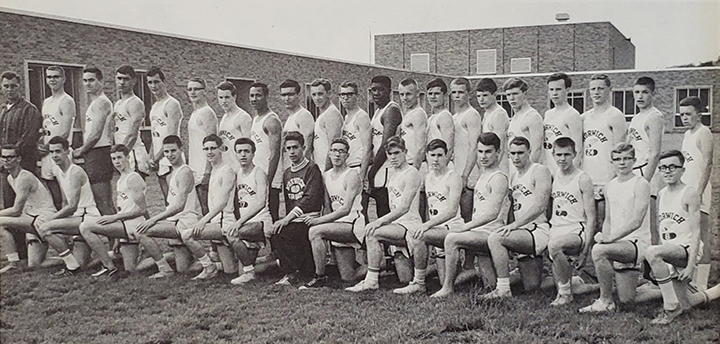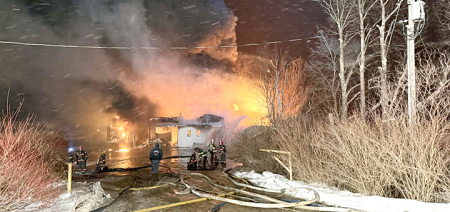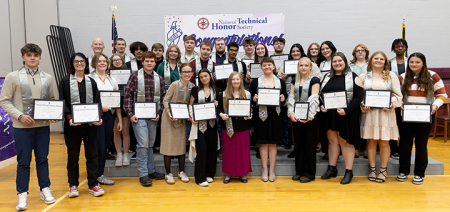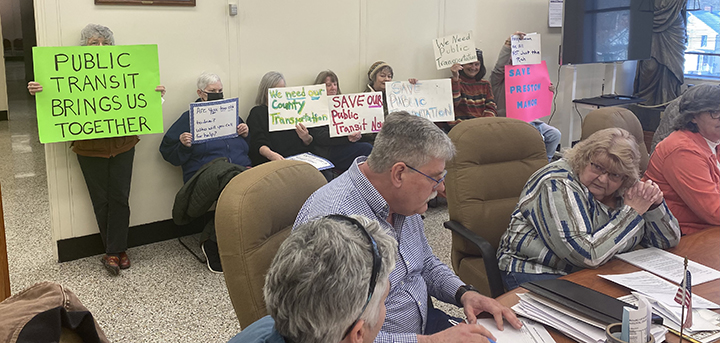Norwich Sports Hall Of Fame: The 1965 Track & Field Team
Published:
October 10th, 2025
By:
Jessica Benson
 The 1965 Norwich High School Track & Field Team. (Submitted Photo)
The 1965 Norwich High School Track & Field Team. (Submitted Photo)
(The Norwich High School Sports Hall of Fame is happy to announce its 2025 induction ceremony will be held on Saturday, Oct. 11, where the 13th Hall of Fame class will be honored. Those being inducted in the 2025 class include athletes Hannah Runyon, Kyle Edwards, Michael Sutton, contributor Jim Wysor and the 1965 track & field team. This year’s event will be held at the Canasawacta Country Club, where a buffet dinner will commence at 5:30 p.m., followed by the induction ceremonies at approximately 6:30 p.m. Tickets to attend are $35 and can be purchased at the front desk of the Norwich YMCA or the Norwich High School by phoning 607-334-1600, Ext 1439.)
From One Fast Track To Another
By: Tom Rowe
For close to a century – 89 years to be exact – the New York, Ontario and Western Railway, commonly known as the O&W, was the lifeblood of Norwich, not to mention countless other cities.
But, by 1948, the operating losses had accumulated to over $38 million. The decrease of coal as a heating fuel for other than major power plants damaged its primary freight business, as did the end of rail transport of high-priority dairy products from Upstate New York to the Metro New York City area. The New York State legislature approved a $1 million aid bill, citing the O&W as essential for civil defense, but the state civil defense commission rejected it.
The bankruptcy court finally ordered complete abandonment, and sadly the last freight train ran from Norwich to Middletown on March 29, 1957. The No. 1 song in the land that day was “Young Love” by Tab Hunter, but a more appropriate Top 10 tune – “Knee Deep In The Blues” by Guy Mitchell – was more apt to be heard throughout the city’s populace.
Liquidation of the railway began in earnest as the O&W became the first Class 1 railroad to be completely abandoned in the United States, but scores of empty buildings still dotted the silent landscape for years, especially between East Main Street and Hale Street. Call it the “seven- year itch” but prior to the opening of the new Norwich High School in 1964, Norwich City School officials took a rosier outlook on that old O&W property as a possible solution to the overcrowding issue at the high school on West Main Street, brought on by the post-World War II “baby boomer” phenomenon.
All aboard for Norwich
As the O&W approached the city from the north during the mid-1950s, it crossed Black Bridge just south of Woods Corners, cut a swath between the Borden Dairy Milk Creamery – later the home to the W.H. Dunne Co. – and the Chenango County Highway Department before it crossed Rexford Street. Continuing its southern route, it bisected Gold Street, where “Plug” Smith manned the crossing, and Mitchell Street – the latter with a western shoe that took it across Silver Street and State Street until it connected with another Norwich railway, the Delaware, Lackawana & Western (DL&W) – before greeting and expanding its tracks on East Main Street after another crossing on Sheldon Street. There, the Sheldon Street Hotel, the first of many small hotels and bars to serve the trainmen, came into play before the expanse of life on East Main Street emerged.
It was at East Main, much like more imposing home stations such as Grand Central Terminal in New York City, Broad Street Station in Philadelphia and Union Station in both St. Louis and Washington, D.C., where passengers embarked and departed, freight was laden, and workmen of all stages exited the trains. After their respective shifts, those trainmen – brakemen, conductors, engineers, firemen and various passenger train crew members – along with passengers when they were so transported, disembarked to many restaurants, bars and small hotels that dotted the landscape.
There, an array of “Little Italy” eateries like the Canto family-owned Globe Hotel, Louie Leggiero’s and “Big” Jim Mirabito’s Ontario Hotel and Randall’s, operated by Jimmy Charles and Joe Portelli put out legendary spreads.
Prior to the advent of the mega grocery stores, three local markets – Sam Taranto & Sons, (Tony) Paino & (Joe) DiStefano and the appropriately named O&W Super Market, run by Joe Angelino and Coney Taranto, supplied not only the rail workers, but the adjacent neighborhood with all the culinary delights one could wish for. And adjacent to the latter store, just around the corner on Adelaide Street, was the O&W Restaurant, a small venue run by Fred Eicke. A few years later, Fred moved his business into where the Star Restaurant had been located on East Main Street, and he and later his family kept Eicke’s a Norwich favorite there for over 60 years until its closing in 2021.
And we must not forget Norwich Knitting Mills, which employed a plethora of Italian-heritage people, and rose just to the west of the O&W tracks. Nestled between the Mill and the Paino & DiStefano grocery was Mossman’s Hotel & Grill, oversaw by the father and son tandem of Bill M. and Bill J. Mossman, on West Railroad Street. These establishments were so proximate to each other no one needed a car to frequent them, but if you were in the market for a new auto, then the dealership to visit was Paglia & Corbacio on the corner of East Main and Railroad Street (now Midland Drive) for a shiny new DeSoto.
From that busy crossing, the rail yards opened to a mass of steely activity, much like an expanding delta of a major river or the spider-like roots of a mighty oak tree, as they headed south to Hale Street. But just before that southern terminal, a massive roundhouse existed. It was there that trains, particularly locomotives, were serviced, repaired and rotated for their return journey. Those giant edifices were typically built around a turntable, allowing locomotives to be rotated to face different tracks for various maintenance and servicing tasks. Unfortunately, the vast majority of these roundhouses were torn down in the 1950s as railroads converted from steam to diesel-electric power, which needed less maintenance.
So, after a complete rehabilitation of the railyard expanse, a new Norwich High School opened its doors in September 1964 to nearly 800 students between 10th and 12th grade. And close to where that roundhouse formerly sat, the Tornado thinclads now had a new track, not exactly round but more oval, to perform their Herculean feats on.
They did not disappoint! After the first two scholastic seasons, 72 would-be NHS Olympians reported for spring tryouts in 1965, 17 of them lettermen from a very successful 1964 campaign. That contingent of sprinters, jumpers, leapers and throwers of the weights won all dual and quad meets they entered in posting an unblemished 10-0 record. Besides that perfect mark, the Tornado also laid claim to the Section III Class B crown, the Iroquois League title and the season-opening Section III Relay Carnival before sending four Purple tracksters to the New York State championships.
For that reason, the 1965 Norwich High School track and field team is one of the newest inductees of the 13th edition of the Norwich High School Sports Hall of Fame.
A SPOTLESS TRACK RECORD WHERE COUNTLESS TRACKS ONCE STOOD
Section III Class B Relay Carnival (1st/15) – Saturday, April 24 (at Rome Free Academy): This day, the official opening of the 1965 season, had been anticipated for nearly 11 months. For on the final afternoon of the 1964 campaign, the 880 relay foursome of Tom Roberts, Mike Ault, Mel Winner and Mike Robertson placed fourth in the New York State championships at Cornell University. With Winner and Robertson being two of the 17 returning lettermen, the Tornado thinclads had high hopes for a most memorable mid-decade spring.
With temperatures in the low 50s and rain slowly coming to a late-morning end, those pre-season aspirations quickly turned to an auspicious opening for the Purple as Norwich headed the final meet tally with 19 points, as Cazenovia and Westhill of Syracuse tied for second with 18 each and Jamesville-DeWitt scored 14 for fourth. Other schools in the season-opening encounter were Fulton (12), Syracuse Vocational (12), New Hartford (11½), Cortland (9), Central Square (6), Liverpool (6), Oneida (5), Vernon-Verona-Sherrill (5), Ilion (3), Carthage (1½) and Herkimer (1). All told, 52 schools competed in the four-class event that featured more than 1,000 competitors.
Heading the list of Purple performers was the discus trio of Joe Casamento, Tom Parks and Larry Welch who produced a relay-best total of 353 feet; 11¾ inches. That same threesome also placed third in the shot put competition. To determine an individual event champion, each entrant is given three throws with his longest toss counted. The three longest tosses are then added together to determine the winner.
“Winning the Section III Relays was very important,” remembered senior sprinter and hurdler Don Cooper. “We knew we would be strong in several running events, but Casamento, Parks and Welch winning the discus and taking third in the shot clinched it for us. Our field events came through, and it gave us the momentum to head into the duals with confidence.”
Runner-up finishes were had by a pair of relay quartets – the 440 of Tom Armstrong, Cooper, Larry Moses and Robertson; and the 880 of Armstrong, Cooper, Moses and Winner.
The final top three finish was turned in by the sprint medley group of Harold Burton, Mike Meyers, Tom Wagner and Winner.
Robertson, who was a sophomore sprinter at the time, echoed Cooper’s feelings. “The importance of getting off to a positive start was illustrated at the Section III Relays. We found out that, as a group, we were very competitive. It gave us the confidence pill. The big guys had done their jobs, but for us new guys, we contributed, too, and felt an immense sense of pride.”
Mohawk (125-8) – Friday, April 30 (Home): After competing at the old Cortland Street track for decades and the grass-covered environs of Veterans Park the past few seasons, Norwich embraced its new cinder track on the site of the now-razed O&W roundhouse with abandon as the Tornado completely outclassed the Mohicans in their initial dual meet of the young spring.
The outcome of the meet was perhaps settled early as the local tracksters had some surprises up their sleeves for the visitors. As NHS senior Dave Stevenson reported in The Evening Sun, “The Tornado pole vaulters had the bar fixed at 12 feet when their opponents from the Valley came by mouths open. Naturally, no Tornado vaulter could come close within a foot and a half of that height, but first impressions are often long-lasting.”
A good-sized crowd had assembled on a warm, gusty spring afternoon to witness the inaugural meet of the year. Moses and Randy Reed kick started the competition with a 1-2 finish in the 120-yard high hurdles, with Mohawk placing third. That, however, would be the Mohicans last bit of success, until the day’s final event – the 880 relay – that Norwich forfeited.
As if an omen was foreboded for the remainder of the competition, the sunny skies turned cloudy, and the Mohawk visitors responded, in turn, by losing all three places in the next 11 events.
Cooper, who earlier ran a “dead-heat” with Armstrong in the 100-yard dash, added a second first in the 180-yard low hurdles with a new school-record clocking of 21.3. Armstrong, meanwhile, followed suit with another victory in the 220. And Winner added his name to the list of double winners with firsts in the broad jump and high jump, the latter in a leap of 6 feet to tie his own school record.
Other victories were posted by Burton (440), Parks (shot put), Wagner (880), Welch (discus), Frank Ault (mile), Tom Drake (pole vault), Rennie Jackson (two mile) and Joe Otto (triple jump).
“Having a new cinder track at the high school was a big plus for us. To be honest, it was always a bit embarrassing to have such a poor facility by comparison to the rest of the leagues,” said Cooper. “It can be hard training on a grass track and dirt approaches and then competing on a totally different surface. Sprinter starts and jumper approaches are so different, so that was a variable we didn’t have to contend with this season.”
Robertson agreed but with a new twist with regard to the track itself. “You would have had to run on that to know just how bad it was. On the far end of the ‘mowed oval’ there was a dip in the ground that would drive your femur through your hip if you hit it incorrectly.
“So, when it came time for the new track, we were all included in the completion of digging the pits and shoveling the sawdust into those pits. I assume this was to save money, but it gave us a sense of ownership. The new track also afforded us the opportunity to wear spikes. It felt really fast compared to the grass and sneakers.”
Needless to say, that season-opening triumph embodied the sleek, powerful locomotives that used to wind their way through the now NHS campus as the Purple thinclads exhibited a combination of speed, strength, endurance and agility.
Quadrangle Meet (1st) – Monday, May 3 (Home): Moving from April to May had no effect on the Tornado juggernaut as Norwich, which tabulated 120 points, took first place in every event except one in completely outclassing Sherburne (27½), Hamilton (6½) and Oxford (5).
With temperatures in the high 70s and lower 80s, Cooper and Burton continued their assault on the NHS record books, with Cooper bettering his time in the 180 low hurdles to 21.0 and Burton setting a new mark of 52.0 in the 440. Cooper made it a double victory day with another first in the 100-yard dash, and Otto followed suit with top-notch performances in the broad and triple jumps.
Moses came through with a first in the 120 high hurdles and later teamed with Meyers, Robertson and Jack Leahy on the 880 relay team to complete another double win, while more victories were turned in by Armstrong (220), Ault (mile), Jackson (two mile), Parks (shot put), Welch (discus), Winner (high jump) and Jim Rice (pole vault).
The only event Norwich was not victorious in was the 880, half-mile race where Lisle Britton of Sherburne turned in a winning time of 2:07.
Little Falls (108-23) – Friday, May 7 (Home): Burton and Jackson set new school records in leading Norwich to another ho-hum victory, this time at the expense of the Little Falls Mounties on a sunny, mid-70s afternoon.
Burton continued his merry mastery over the 440 with a time of 51.8, and Jackson felled the two-mile mark with a 10:29.2 clocking.
Ault again lowered his mile marking with a victorious time of 4:53, while double firsts were had by Cooper (100 dash and 180 low hurdles), Drake (880 and pole vault) and Winner (high and broad jumps). The remainder of the triumphs were turned in by Armstrong (220), Leahy (120 high hurdles), Otto (triple jump), Parks (shot put) and Dave Carpenter (discus).
Chenango Forks (105½-30½) – Tuesday, May 11 (Away): Heat and humidity failed to slow Cooper as the spirited senior sprinter tied an 18-year-old record with his 10.1 mark in the 100-yard dash. Cooper’s clocking matched Ralph Boyer’s, which was set back in 1947. But Cooper’s record was especially outstanding considering the fact that he ran it on a grass track.
The lopsided victory was even more impressive because the Tornado was without the services of Drake (880 and pole vault), Moses (120 high hurdles), Wagner (880) and Hank Scudder (discus and shot put), all of whom were sidelined with injuries.
Helping pick up the slack for the Purple was a clean 1-2-3 sweep in the two-mile run (Jackson, George Burton, George Hitt), the 220 (Armstrong, Robertson, Meyers), the discus (Welch, Carpenter, Casamento) and the 100-yard dash where Armstrong and Robertson followed Cooper across the finish line.
The remainder of the Norwich victories were posted by Ault (mile), Harold Burton (440), Otto (broad jump), Parks (shot put), Rice (pole vault), Winner (high jump), Joe Caravaglio (880) and two relay teams – the 880 (Cooper, Robertson, Armstrong, Winner) and the mile (Reed, Meyers, Leahy, Ed Smith).
Frankfort-Schuyler (68-63) – Friday, May 14 (Away): After four consecutive dual-meet laughers and another during a quadrangle affair, the Tornado was put to the test by its Maroon Knight hosts on a relatively fair and mild day.
There is no better way to recap what transpired that afternoon 60-plus years ago than to let Dave Stevenson tell you exactly what he wrote in The Evening Sun that following Monday.
____________________
“It all came down to the final race – the 880-yard relay and the Norwich cindermen, paced by a fantastic start by Don Cooper, edged the Frankfort foursome and won a track thriller last Friday, 68-63.
“The afternoon started out as another Norwich rout, with the local squad ahead, 42-21, after the first 7 events.
“But Frankfort put on the pressure in the 8 remaining contests.
“They grabbed 8 of 9 points in the 180-yard low hurdles when Cooper fell and Bob Conley passed him to win.
“Joe Ferraro, the heralded football-wrestling-track star, threw the discus 140 feet, 11 inches to make the score 47-34.
“Frankfort’s 14-year-old triple jumper, Frank Cioch, jumped 40 feet, 5¾ inches, and the score was 48-42.
“Tom Armstrong’s 23.5-second timing in the 220 gave the Tornadoes a little breath, 53-46.
“But Frankfort won the first two places in the 880, paced by Tony Ahern’s 2:02.1, to even the score at 54 apiece.
“Larry Moses and Mel Winner took first and third, respectively, in the high jump to put Norwich up, 59-57.
“Then Frankfort countered with a first and third in the pole vault to again tie the score, this time at 63-up.
“Then came the relay.
“Cooper got off to a terrific start. Passing his man by several yards at the first turn.
“Mike Robertson ran second, staying just ahead of his man. He handed the baton to Tom Armstrong, who, knees wobbling from a leg injury, maintained the lead long enough to pass the bar to Mel Winner, who galloped home for 5 points and a Norwich track victory.”
____________________
Giving the Purple much-needed points were a pair of clean sweeps in the 100-yard dash and the two-mile run. Cooper, Armstrong and Robertson went 1-2-3 in the sprint, while Jackson, George Burton and Hitt did likewise in the day’s longest venture.
“When I was a freshman and Coach Grzibowski was just building a track team, he spent a lot of time recruiting young guys. He was adamant that football players run track if they weren’t on the baseball or tennis team,” recalled Cooper. “He was excited about the future possibilities, and it was infectious.
“By the time we were seniors, we were deep in almost every event. We often swept events and oftentimes, if we didn’t win the event, we took second and third,” pointed out Cooper in reference to the team’s nailbiter against Frankfort. “We knew that in the close meets, where their talent was competitive with ours, the seconds and thirds would decide the winner. The numbers paid off for us.”
Moses added a victory in the 120-yard high hurdles to go along with his first in the high jump, Harold Burton again won out in the 440 and Ault cruised to a blue ribbon in the mile.
The outcome probably would not have been so close if Norwich had not been riddled again with injuries. Both 880 men, Drake and Wagoner, were unable to compete, Drake also being a pole vaulter and triple jumper, while Scudder (discus and shot put) sustained a chipped ankle.
Oneonta (66-65) – Wednesday, May 19 (Away): The second road trip in five days did not prove to be any easier on the Tornado trackmen, especially since the rash of injuries that had beset them continued to grow in number.
But despite those maladies, the Purple once again stole victory from the jaws of defeat when they rallied from a 65-61 deficit with a triumph in the meet’s final event – the 880 relay. Doing the honors on that quartet were Cooper, Robertson, Armstrong and Winner, the same NHS thinclads that produced the dramatic victory at Frankfort. This time they lowered their winning effort by two-tenths of a second, clocking out at 1:36.1, as compared to the 1:36.3 they manufactured at Frankfort.
Along the way on that turbulent afternoon that produced scattered thunderstorms, Moses and Cooper established a pair of new school records. Moses ran to a record 15.85 in the 120-yard high hurdles, while Cooper lowered his own mark in the 180-yard low hurdles to 20.6.
Cooper also notched a first in the 100-yard sprint, Ault and Harold Burton kept their respective strangleholds on the mile and 440 in place, Parks copped the shot put, Jackson loped to victory in the two mile and Armstrong raced to the 220 crown.
While Norwich held a slim 8-6 edge in victories prior to the meet-deciding 880 relay, it was that all-important depth that carried them to victory. Time and time again, the Purple came through with seconds and thirds to offset many of the firsts turned in by the Yellowjackets.
Runner-up finishes were had by Armstrong (100 dash), Carpenter (discus), Moses (high jump), Rice (pole vault) and Winner (broad jump), while thirds were run up by Dave Bishop (880), George Burton (two mile), Caravaglio (mile), Robertson (220), Welch (discus) and Winner (triple jump).
These added points were necessary since injuries continued to hamper Norwich in fielding a full lineup. Sectional champion Otto (triple and broad jump) was sidelined with a back injury, Winner, trying to lessen the slack left by Otto, could not enter his best event, the high jump and John Doyle was lost for the 440. Then, Drake, still suffering from a sprained ankle, found that he was incapable of entering either the pole vault, 880 or triple jump. Welch, the leading discus man, also suffered a sprained ankle and as a result finished only third. Plus, he could not enter the shot put, where he would at least have had a second place.
“Injuries hit early and often, but the team psyche was that no one person was as important as the team,” explained Robertson. “We had the idea that we could overcome a few important losses by filling in the team scoring as was illustrated against both Frankfort and Oneonta.”
Ilion (87½-43½) – Friday, May 21 (Home): Norwich put the cap on its final home dual by knocking off reigning Iroquois League champion Ilion, the only team to defeat the Tornado last year.
On a fair-sky Friday afternoon, the Purple easily handled the Golden Bombers by almost the same score – 66-47 – that they lost to them by 12 months earlier. Supplying the Tornado with a pair of “A-plus” efforts were Armstrong and Ault, who both etched their names on the school record slate. Armstrong tied his teammate Cooper’s 100-yard dash mark of 10.1 and Ault, triple jumping for only the second time, bettered Otto’s old record with a leap of 41-feet; 6½-inches.
The “A-Team” duo were also double winners, Armstrong sprinting to victory in the 220, while Ault gained the day’s accolades in the mile. Moses was the other double champion, tying for first in the 120-yard high hurdles and winning the high jump.
Besides that half dozen of triumphs, Norwich gained top performances from Harold Burton (440), Cooper (180 low hurdles), Jackson (two mile), Parks (shot put), Welch (discus), Winner (broad jump) and the 880 relay quartet of Robertson, Winner, Leahy and Cooper.
Showcasing its depth once again, Norwich swept the 100 with Cooper and Robertson falling in behind Armstrong, the two-mile where Hitt and George Burton performed likewise behind Jackson and the 180 low hurdles that featured Leahy and Mike Kane in second and third place, respectively.
Herkimer (89-42) – Wednesday, May 26 (Away): Norwich closed out an unblemished Iroquois League season at 6-0 with victories in 12 of the 15 contested events.
Cooper broke the school record in the 100-yard low hurdles with an 11.6 clocking, while Armstrong matched his time of five days before in the 100 with a mirror time of 10.1. Another mark nearly fell, too, as Carpenter let loose with a throw of 142-feet; 11-inches, just five and one-half inches shy of the record set by Sterling Higley back in 1949.
Armstrong made it a double triumph day with a first in the 220, while Ault (mile and triple jump) and Moses (120 high hurdles and high jump) followed suit. The remainder of the victories were posted by Bishop (880), Harold Burton (440), Jackson (two mile) and Parks (shot put).
The host Magicians captured three events with individual champions in the broad jump and the pole vault and a relay foursome in the two-fifths mile. That meet-ending relay was reported in humorous text by Dave Stevenson in The Evening Sun as Norwich took some liberties with its four entrants.
____________________
“The relay was of particular interest to all sports-minded individuals who divine excellent form and speed. Mike Robertson and Jack Leahy gave the Tornadoes a healthy lead. Leahy handed off to discus-thrower Dave Carpenter, who, with a running style somewhat reminiscent of Wilt Chamberlain and Sonny Liston, passed the baton to astute shot putter Charley George. Carpenter had already lost the lead, so Charley, working much like an IBM robot, proceeded to give a little more ground as Herkimer’s Kirk broke the wire and garnered 5 big points for the tough Green and White.
“Actually, anyone could tell Charley was giving his all, as he turned his head to spit on the last turn.”
____________________
Iroquois League Championships (1st/7) – Saturday, May 29 (at Norwich): After narrowly defeating both Oneonta (one point) and Frankfort-Schuyler (five points) during regular-season dual meets, Norwich outclassed its foes at every turn. The Tornado posted 57½ points to the Yellowjackets’ 35 and the Maroon Knights’ 33½, while Ilion scored 15, Herkimer 5, Mohawk 1 and Little Falls 0.
The victory also marked the first Iroquois League team championship for Norwich since the title claimed by the wrestling troupe following the 1958-59 campaign.
On the day, the Purple produced eight firsts, four seconds, one third and four fourths.
Four Tornado thinclads established new Iroquois records. Armstrong ran to a new mark of 22.1 in the 220, Cooper went 20.9 in the 180 low hurdles, Jackson toured the two mile in a new clocking of 10:24.6 and Moses reached 6 feet in the high jump.
Making up the other four triumphs were Ault with a double in the mile in a personal-best time of 4:43.3 and the triple jump, Armstrong in the 100 (10.2) to complete a double for himself, too, and Parks with a toss of 51-feet; 10¾-inches in the shot put.
Of particular note, Norwich failed to place in only two events – the 880 and the pole vault.
Section III Class B Championships (1st/22) – Saturday, June 5 (at Jamesville-DeWitt): With an undefeated Iroquois League season at 6-0, a runaway victory in the Iroquois League championships, a season-opening triumph in the Section III Relay Carnival, a dominant triumph in a quadrangle meet with Sherburne, Hamilton and Oxford and a pasting of the Southern Tier’s Chenango Forks in a non-leaguer – what more could you ask for?
How about a lopsided victory over 21 other schools in the Section III Class B meet at Jamesville-DeWitt to secure the first Section III team crown since the one captured by the Tornado wrestling squad in 1959. And that championship was headed by a trio of record setters – Cooper, Armstrong and Parks. Cooper established a new sectional mark in the 180 low hurdles with a time of 20.6. Armstrong ran an amazing 9.8 in the 100 – the second fastest time in the state – but had to settle for a runner-up finish as Bill Henderson of Syracuse Vocational passed him with five yards to go in a blistering time of 9.7. Parks, meanwhile, pumped the shot put 51-feet; 9¾-inches to secure a new Class B mark.
Norwich, which placed six men in seven events, also gained four thirds from Armstrong (220), Ault (triple jump), Harold Burton (440) and Otto (broad jump). Also earning points for the Tornado were Carpenter with a fourth in the discus, Cooper with a fifth in the 100 and Moses with a fifth in the 120 high hurdles. Moses was hampered in his bid when his spikes stuck in the starting blocks.
The reported team scoring had Norwich with 30 points, Syracuse Vocational, Vernon-Verona-Sherrill and Westhill tied for second with 19 each and Cazenovia and Oneonta deadlocked in fifth with 16 apiece.
Overall Section III Championships – Tuesday, June 8 (at Rome Free Academy): Cloudy skies and intermittent showers failed to deter the Norwich thinclads as four Purple trackmen qualified for the New York State championships at Cornell University.
Cooper led that four-man contingent with another sectional record with a blistering 20.4 to capture first place in the 180-yard low hurdles. It was just three days prior that he clocked 20.6 in the same event to be crowned a Section III Class B champion.
Joining Cooper on that trip to Cornell were Armstrong, Parks and Harold Burton. Armstrong gained a pair of thirds in both the 100- and 220-yard dashes, losing out by one-tenth of a second in the former and three-tenths of a second in the latter. Parks, meanwhile, claimed a second place in the shot put, while Burton’s fourth place finish in the 440 qualified him for a spot on the sectional distance medley team. That foursome is made up of the third and fourth place finishers in the 440, the third place 880 runner and the third place miler.
New York State Championships – Saturday, June 12 (at Cornell University): The laurel wreaths of victory were finally laid aside as the assembled Norwich quartet failed to take home a state title.
Burton, running the 440 leg of the Section III distance medley team, placed fifth with his teammates. Parks finished in the top 10 during shot put competition, Cooper was ousted in the semifinals of the 180-yard low hurdles and Armstrong lost out in the trials for both the 100 and 220.
Perennial powerhouse Section VIII of Nassau County laid claim to its 15th consecutive state crown, while Section III finished eighth.
FAST TRACKING THE TEAM’S ACCOMPLISHMENTS
Over the course of 10 short weeks, this ensemble of jumpers, leapers, sprinters and throwers engineered performance after performance of track success that would have truly brought smiles to the faces of the countless men who toiled in these same environs as members of the O&W Railroad family.
“Going into the 1965 track season, the team was excited and cautiously confident,” noted Cooper. “We felt that barring injuries or unforeseen circumstances, we could potentially run the table of Section Relays to start the season, win the Iroquois League and finish first in the Section III Class B meet. We had finished strong in ’64 and we knew some of the younger guys were going to develop.”
One of those younger guys was Robertson, who led a large group of soph point getters. “Although 70-plus guys came out for the team, we watched as one by one the filtration system convinced those less capable of the standards set by Coach (Grzibowski) began to fade from our numbers. As the core became more and more apparent, the pride of inclusion for us ‘younger’ guys grew and grew. To go into the locker room with the likes of Armstrong, Cooper, Drake, Jackson, Otto, Parks, Scudder and Winner and the rest was both exhilarating and intimidating.”
In addition to the unblemished dual and quad meet record, the Section III and Iroquois League championships, this heralded group of thinclads produced nine new Norwich High School track and field records, and a Section III and Class B record.
Tom Armstrong topped the sprinters with new NHS-best times in the 100- and 220-yard dashes. He was clocked at 9.8 in the former – the second fastest time in the state – and chimed in with a 22.1 posting in the latter.
Don Cooper also laid claim to a pair of new marks, with a sectional-best 20.4 in the 180-yard low hurdles, while adding an 11.6 in the 100-yard low hurdles.
Larry Moses was the third two-time record setter as he went 15.85 in the 120-yard high hurdles, while tying teammate Mel Winner for the high jump mark at 6 feet.
The remaining three new Tornado marks were established by Frank Ault in the triple jump (41-feet; 7-inches), Harold Burton in the 440 (51.8) and Rennie Jackson in the two mile (10:24.6).
Although not a Purple record, Tom Park’s shot put toss of 51-feet; 9¾-inches was good enough for a new Section III Class B mark.
So, eight-plus years after the O&W, a railway forever etched in the city’s lore, traversed the tracks of Norwich for the final time, a new track in the wake of the roundhouse was the site of current exploits. Those feats were not produced by the power of steely locomotives, but by the zeal and fortitude of young men, who, like their forerunners on the railroad, kept their inner engine fires stoked on their way to a memorable ride during the springtime of 1965.
“The success of this team started when we were freshman and Coach Grzibowski made an effort to build a superior track team,” pointed out Cooper when asked what aspects of the team made for its great success. “Over the four years he worked year-round to develop the hunger, confidence and results for our individual competitors. It was critical that most everyone bought in.
“I can’t believe that any track coach ever did more planning and preparation than Coach Grz,” continued Cooper. “He would have a few of us in his office and show us his projected results for the next meet. He would ask what we thought and he would move people around in events to give the team its best chance.”
One such move was when Coach Grzibowski, just a few weeks after football ended, decided to replace Cooper in the 220 with a young Robertson, having Cooper concentrate on the low hurdles, instead.
“Grz already had points figured for the spring, and he proved to be almost omniscient,” said Cooper. “I always looked at this track team as a tribute to the efforts of a coach who cared about physical, mental and character development. He was the sculptor. We were the clay.”
There have been countless songs sung about trains over the years, tunes such as “Chattanooga Choo Choo” by Glenn Miller, “Mystery Train” by Elvis Presley, “Rock Island Line” by Lead Belly and “Wabash Cannonball” by Roy Acuff. But when discussing the history and exploits of the 1965 Norwich High School track and field team, no song fits the bill more appropriately than gospel and rhythm-and-blues singer Sister Rosetta Tharpe’s rendition of “This Train Is Bound For Glory.”
I say, Amen to that!
E CREW
*Al “Jim” Armondi
Mike Kane
Tom Armstrong
Jack Leahy
*Frank Ault
Dave Lisiesky
Jim Benedict
Mark Mahoney
Dave Bishop
*Rick Melloy
*George Burton
*Mike Meyers
*Harold Burton
Larry Moses
Ed Capria
*Charles “Joe” Otto
Joe Caravaglio
Tom Parks
Dave Carpenter
LeRoy Phillips
Joe Casamento
Randy Reed
Don Cooper
*Jim Rice
Mike Cummings
Scott Ripley
*John Davis
Mike Robertson
John Doyle
Tom Rowlison
Tom Drake
*Hank Scudder
Charlie George
*Dominic Spinella
*George Hitt
Ed Smith
*Russell “Rusty” Husted
*Tom Wagner
*Rennie Jackson
*Larry Welch
John Kalicicki
Mel Winner
THE ENGINEER
*Coach Joe Grzibowski *Deceased
Comments





